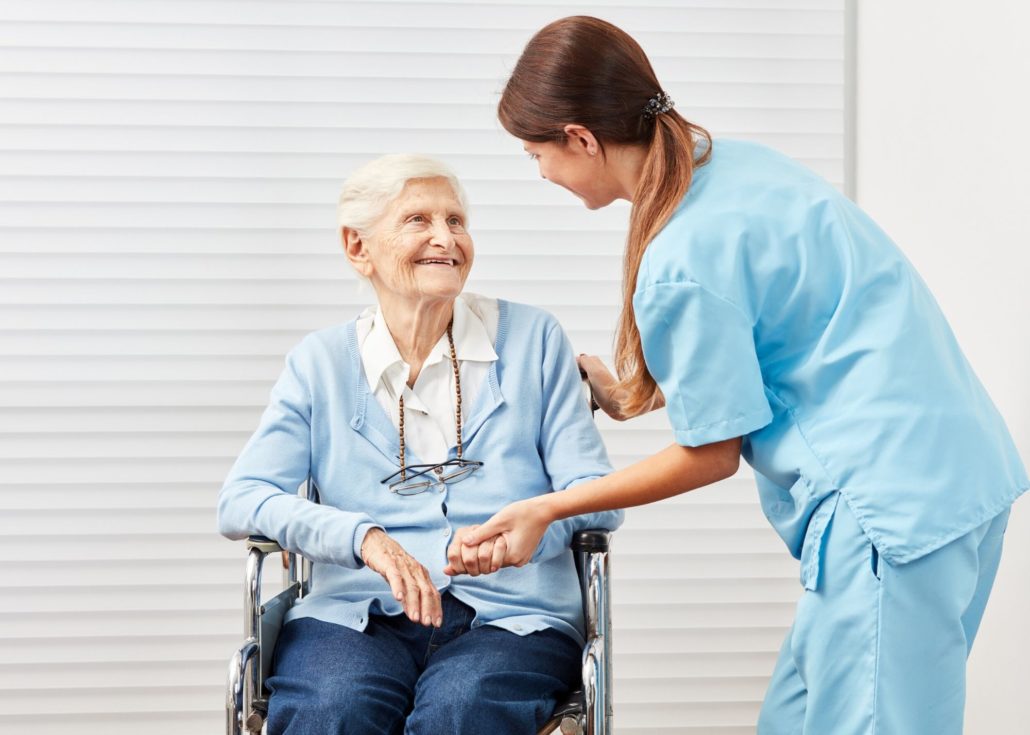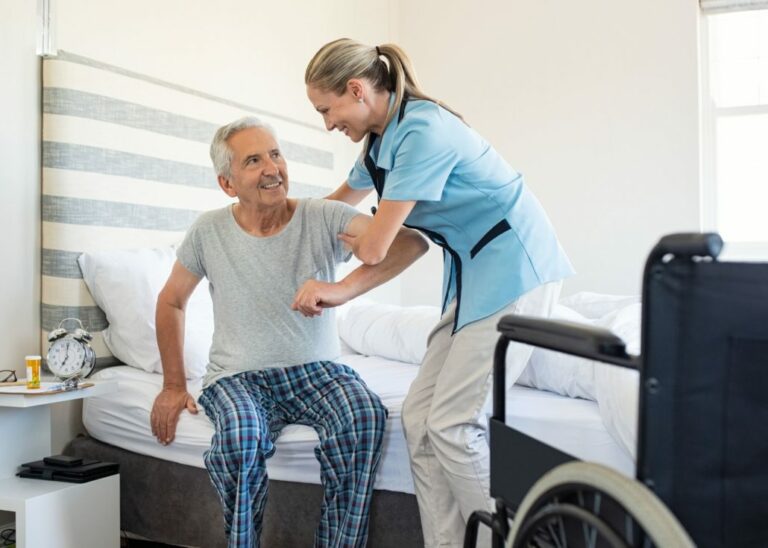One approach to creating a safer environment for seniors is applying the methods of universal design. Universal design focuses on designing, constructing or adapting buildings, products and environments to make them accessible to all people, regardless of age or disability.
In order to devise a customized solution for your loved one’s residence, carefully assess each room and use the following tips to make modifications and improvements that allow a senior to live at home as long as safely possible.
Read More: INCREASE SENIOR INDEPENDENCE WITH THIS FALL RISK CHECKLIST

Home Modifications for Aging in Place
General Household Safety Tips
- Move furniture to clear walking paths.
- Make light switches accessible by placing them no higher than 48 inches and replacing toggle switches with rocker style
- Improve overall lighting in the home. Light dark pathways or countertop areas with easy to install rope lighting. Add task lights and night lights wherever needed.
- Replace doorknobs with levered handles or pulls or add doorknob grips.
- Mark changes in floor levels with tape or paint in a high-contrast color.
- Remove loose carpeting and unnecessary throw rugs. Fasten down area rugs with double-sided rug tape.
- Remove all electric, cable and extension cords that run across or near walkways. If necessary, place electric cords behind furniture.
- Replace unsteady chairs with chairs that have sturdy arms to make transitioning from sit-to-stand easier.
- Lock thermostats to control temperature.
- Remove clutter by donating or disposing of items that are no longer of use.
- Make sure trash receptacles are easily accessible from inside the home and can be brought to the curb without obstruction.
- Repurpose a closet or other area on the main living level to make laundry machines accessible. Replace top-loading machines with front-loading appliances that are easier to use. If necessary, laundry can be outsourced to a per pound laundry service or added to the tasks completed by a personal home care aide.
- Ensure smoke alarms and carbon monoxide detectors are placed in all key areas. Test them and change batteries regularly.
Entryway Safety Tips for Seniors
- Clear a convenient path from the driveway to the entry.
- Ensure walkways are free from loose bricks and cracks.
- Remove or trim landscaping so that walking paths are wide enough for someone using a wheelchair or walker.
- If there are entry steps, install handrails on both sides of any stairs and ensure stair treads are non-slip and deep enough for the whole foot.
- As mobility challenges increase, evaluate if there is room for the installation of a ramp.
- Evaluate the safety of the front door. Are locks sturdy and easy to operate? Is there a window panel or peephole in the proper location?
- Step-less entries make it easier and safer to gain access, whether the person is in a wheelchair or using a walker or cane. Install threshold ramps wherever possible.
- Add swing-clear hinges to doors or hire a handyman to widen existing doorways.
Kitchen Safety Tips for Seniors
- Increase wattage of lightbulbs in task areas for better visibility.
- Replace cabinet knobs with easy to operate levers or pulls.
- Move frequently used items from high shelves and cabinets to countertops or under-the-counter cabinets.
- Consider the functionality of older appliances. Ideally, oven controls should be placed at the front of the range rather than toward the rear to prevent reaching over the stove. Knobs should be clearly labeled and easy to use. A thin layer of paraffin wax or petroleum jelly can be rubbed around the gasket of a refrigerator door that is difficult to open.
- Replace small appliances, such as coffee makers and toaster ovens, with models that have an automatic shut-off feature.
- Use colorful dishes, utensils and cookware that contrast with the color of countertops, tabletops and storage areas to help an elder with poor eyesight navigate the kitchen.
- Thermometers and timers with flashing lights or voice capabilities can be used to alert someone that dinner’s ready.
- Push the kitchen table against the wall to open up floor space.
- Use a “Lazy Susan” to increase access to out-of-reach items on the dining table or on shelves.
Bedroom Safety Tips for Seniors
- Clear the walking path of any furniture or rugs that may cause tripping.
- Adjust the bed height for easy transfers. If a senior cannot comfortably sit on the edge of the bed with their knees bent and their feet on the floor, adjust the height with risers if it’s too low, or by removing or using a low-profile box spring if it’s too high.
- Add bedrails or pull-up devices under the mattress to assist with sitting up when in
- Add a working flashlight to the nightstand.
- Consider adding a bedside commode to avoid nighttime trips to the bathroom.
Bathroom Safety Tips for Seniors
- Install grab bars for additional support while toileting and while getting into and out of the shower/bath.
- Abundant lighting for the overall space as well as tasks is essential. Special waterproof incandescent lights should be placed in the ceiling of a shower and over a tub for extra visibility.
- Set the hot water heater to 120 degrees Fahrenheit or lower, clearly label hot and cold faucets and consider installing anti-scald devices on faucets to prevent burns.
- Showers should have a step-free entry. There are step-in tub models available that feature a door for easy entrance and exit. The shower should be fitted with a seat, a hand-held shower sprayer, and a niche to hold soap and shampoo at a level that can be reached easily.
- Floors should be slip-resistant wood, vinyl, or tile with a lot of grout for traction. Add non-skid decals to any slippery areas in the bathroom.
- All cabinets and drawers should be fitted with levers or pulls rather than knobs.
- A comfort-height toilet model should be selected that is 2 inches higher than normal and easier to transfer onto from a wheelchair. A toilet seat riser can be added to an existing toilet.
- Lighting modifications along a hallway can provide a clear path to a bathroom in the dead of night when eyesight is failing.
- Curbless showers with a bench allow someone to roll a wheelchair in and bathe.
Read More: WHEN IS IT TIME TO HIRE IN-HOME CARE?
Monitor Changes in a Senior’s Abilities
Care needs change over time. Superior Senior Home Care created an assessment checklist to evaluate a senior’s ability to function independently in their environment. Use this checklist as a guide for home modifications that can help improve an elder’s functional independence. As your aging loved one’s needs and abilities change, use this tool to develop a targeted care plan of appropriate services and support.
You can also take advantage of all the services Superior Senior Home Care provides to ensure the safety and quality of life of your loved one, while removing a lot of the burden off of your shoulders.
Superior Senior Home Care offers a complimentary consultation with an advisor to help you determine your loved one’s home care needs. To schedule your free consultation, call 805.430.8767 or contact us online.


